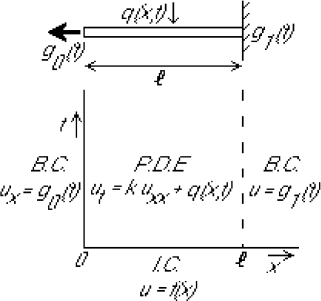| Heat conduction in a bar using separation of variables |
|
|
|
Figure 2:
Heat conduction in a bar.
 |
- Finite domain
 :
:

- Unknown temperature

- Constant
 , so a linear constant coefficient PDE.
, so a linear constant coefficient PDE.
- Parabolic
- Inhomogeneous
- One initial condition
- One Neumann boundary condition
- One Dirichlet boundary condition
- All of
 ,
,  ,
,  , and
, and  are given functions.
are given functions.
We would like to use separation of variables to write the solution
in a form that looks roughly like:
Here the  would be the eigenfunctions. The
would be the eigenfunctions. The  cannot be
eigenfunctions since the time axis is semi-infinite. Also,
Sturm-Liouville problems require boundary conditions at both ends,
not initial conditions.
cannot be
eigenfunctions since the time axis is semi-infinite. Also,
Sturm-Liouville problems require boundary conditions at both ends,
not initial conditions.
However, eigenfunctions must have homogeneous boundary conditions, so
if  was written as a sum of eigenfunctions, it could not satisfy
the given inhomogeneous boundary conditions. Fortunately, we can
apply a trick to get around this problem.
was written as a sum of eigenfunctions, it could not satisfy
the given inhomogeneous boundary conditions. Fortunately, we can
apply a trick to get around this problem.
![]() was written as a sum of eigenfunctions, it could not satisfy
the given inhomogeneous boundary conditions. Fortunately, we can
apply a trick to get around this problem.
was written as a sum of eigenfunctions, it could not satisfy
the given inhomogeneous boundary conditions. Fortunately, we can
apply a trick to get around this problem.